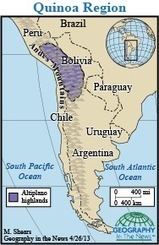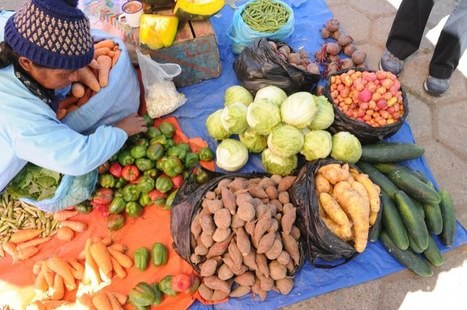"The popularity of Quinoa has grown exponentially among the health-conscious food consumers in the developed economies of the world. Quinoa (pronounced KEEN-wah) is rich in protein and is a better grain for those seeking to lose weight. Quinoa has historically be rather limited but this diffusion is restructuring the geographic patterns of many places."
Get Started for FREE
Sign up with Facebook Sign up with X
I don't have a Facebook or a X account

 Your new post is loading... Your new post is loading...
 Your new post is loading... Your new post is loading...
|
Felix Ramos Jr.'s curator insight,
February 28, 2015 5:50 PM
This is a fine example of people looking out for one another. It might be easier to industrialize their food market but it's more admirable to preserve tradition, help small indigenous business, and try your best at making the country more healthy. I applaud them for doing this. 
Brian Wilk's curator insight,
March 22, 2015 3:33 PM
I think I might want to move to Bolivia one day! Reciprocity is often a term used for corporate culture; you but from me and I'll buy from you type of relationship. This is still true in Bolivia only they do it on a much more personal level. Farmers share equipment, they share crops, seeds and develop a rapport not easily undone by corporations such as McDonald's. Bolivia's multiple micro-climates allow it to grow a wide variety of foods for their citizens, thus making it easier to trade within their circle of neighborhood farmers. "I'll trade you ten pounds of potatoes for five pounds of Quinoa." The article goes on to state that Bolivians do indeed love their hamburgers, a handful of Subway's and Burger King's still do business there, but the heritage of picking a burger from a street vendor has been passed down by generations. These cholitas, as they are called, sell their fare in the streets of Bolivia and this type of transaction is not easily duplicated by large corporations. I have added Bolivia to my bucket list...
Tanya Townsend's curator insight,
October 30, 2015 10:28 PM
" Whats Bolivia doing so right that McDonalds couldn't make it there?" Food is not a commericial space here. Morales, speaking to the United Nations General Assembly in February, slammed U.S. fast-food chains, calling them a “great harm to humanity” and accusing them of trying to control food production globally. “They impose their customs and their foods,” he said. “They seek profit and to merely standardize food, produced on a massive scale, according to the same formula and with ingredients which cause cancers and other diseases.” Even still, with one of the lightest carbon footprints in the world, cherished food practices and progressive food sovereignty laws on the books, Bolivia could still be a model to the rest of the world—the United States especially—for a healthier, more community-based food system.
What an insightful read. I never thought of considering our food a s a "commercial space" but that is essentially exactly what it is. Our food has been extremely commercialized. Products our pushed through advertisement continuously. Most of the foods in America are not even real food but food products, factory made. This is absolutely a role model country for how food should be consumed. |











Quinoa appears to be originated as grain crop for edible seeds in parts of Bolivia, Argentina, Peru and along to Andes Mountain. However, they increase the crop value as it spreads to other areas of the world such as Europe and United States. One thing that I wonder is that if the production is going to be popular in any region other than South America but manufacturing regions started on eastern United States and they spread overseas to Europe. I wonder if production of Quinoa will spread to other continents. Believe it or not, it has partially spread to small parts of southwestern Europe.
Quinoa will be a staple for generations to come and the countries of Peru, Bolivia, Uruguay and Argentina would do well to provide all the assistance to the farming community in their respective countries. This product is like New Age rice, it provides multiple benefits to health conscious consumers such as protein, fiber, and a "full" feeling when consumed. Any recipe that calls for a rice base can incorporate Quinoa just as easily and it tastes great. being a bit of a health freak, I use Quinoa in my diet and it works.
While the success of the grain has made it less accessible price-wise to those who grow it, it should provide for a greater economic benefit for years to come, lifting a population from near poverty levels to hopefully one of a strong and vibrant middle class.
Quinoa has been grown in the high mountains of the Andes for decades and has been a localized food for the population. As their health benefits became known in to the global community, the demands for them increases. This made it difficult for the locals to find cheap Quinoa, which is normally eaten in their diet. I feel that it is unfair for the locals to have seek new source of food alternatives now that their healthy Quinoa will become more expensive as the demand for it goes up.